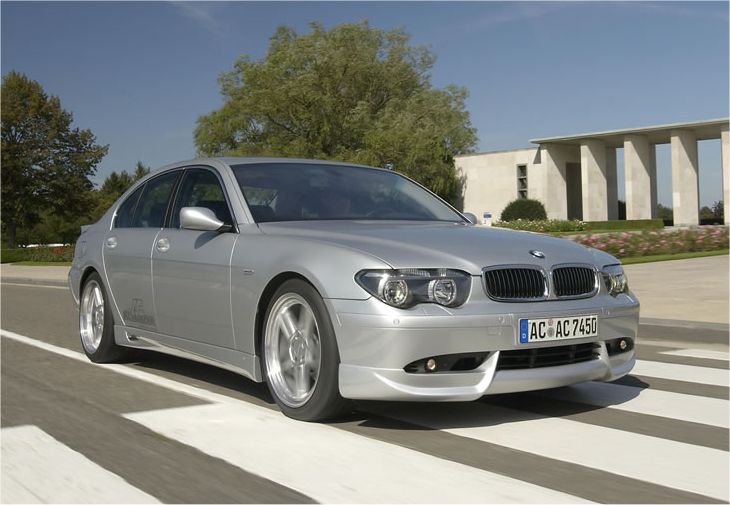German automotive craftsmanship reached new heights in 2003 when AC Schnitzer unveiled their interpretation of BMW’s flagship 760Li. The ACS7 emerged as more than just a modified luxury sedan — it represented a masterclass in precision engineering and bespoke refinement.
The collaboration between BMW’s engineering prowess and AC Schnitzer’s modification expertise produced a vehicle that transcended conventional luxury standards. Each ACS7 stood as a testament to the possibilities of automotive customization, combining performance enhancements with tasteful aesthetic refinements.
Power and Performance: The Heart of ACS7
The ACS7’s powerplant options showcased AC Schnitzer’s commitment to engineering excellence. The V8 variant, displacing 4,398cc, delivered 333 horsepower at 6,100 RPM, while the more potent V12 configuration pushed the performance envelope further. The engine’s architecture, featuring a 92mm bore and 82.7mm stroke, was optimized for both power delivery and refinement.
Fact!
The ACS7's engine management system was specifically calibrated by AC Schnitzer engineers to maintain BMW's reliability while extracting additional performance potential.
“The ACS7’s power delivery is remarkably linear,” notes Marcus Weber, veteran BMW technician. “AC Schnitzer managed to enhance performance without compromising the underlying refinement that makes these cars so special.”
The sophisticated cooling system and optimized compression ratio of 10.5:1 ensured consistent performance under various driving conditions. AC Schnitzer’s modifications focused on enhancing throttle response and torque delivery while maintaining the characteristic smoothness expected from a luxury sedan.
Design Evolution: Beyond Factory Aesthetics
The Black Sapphire exterior finish served as a canvas for AC Schnitzer’s design philosophy. Each aerodynamic modification, from the front splitter to the rear diffuser, was purposefully engineered to enhance both form and function.
Consider these distinctive exterior elements that set the ACS7 apart:
- custom-designed AC Schnitzer wheels with optimized weight distribution;
- aerodynamically tested body modifications for improved high-speed stability;
- signature exhaust system with distinctive sound characteristics;
- bespoke suspension components for enhanced handling precision;
- handcrafted exterior trim elements showcasing German craftsmanship.
“During the development phase, we focused on creating a cohesive design language,” explains Dr. Thomas Kruger, former AC Schnitzer design chief. “Every modification had to serve both an aesthetic and functional purpose.”
Important!
Each ACS7 underwent a rigorous 200-point inspection process before delivery, ensuring every modification met AC Schnitzer's exacting standards.
Market Impact and Legacy
The ACS7’s market position reflected its exclusive nature, with documented sales reaching figures as high as £5,625 at prestigious auctions. This value proposition extended beyond mere luxury, encompassing the vehicle’s limited production numbers and comprehensive modifications.
Low-mileage examples, such as the documented 58,000-mile specimen, demonstrate the careful ownership typically associated with these vehicles. The ACS7’s presence in both left- and right-hand drive configurations expanded its market appeal across international borders.
Historical Reference!
The ACS7 program marked AC Schnitzer's most comprehensive modification package for a BMW 7-series, setting new standards for luxury vehicle customization in the early 2000s.
Expert Analysis and Future Outlook
The ACS7’s true value proposition lies in its dual nature as both a usable luxury sedan and a collectible modern classic. The robust V8 and V12 powertrains, when properly maintained, have proven reliable despite their complexity.
Technical specifications worth noting:
- Maximum speed: 250 km/h (electronically limited)
- Seating capacity: 5 passengers
- Door configuration: 4-door sedan
- VIN example: WBAGN820X0DE78317
Investment potential remains strong, particularly for well-documented examples with complete service histories. The ACS7’s limited production numbers and increasing appreciation for early 2000s German performance vehicles suggest continued market stability.
A Lasting Testament to Precision
Two decades after its introduction, the AC Schnitzer ACS7 continues to exemplify the potential of thoughtful automotive modification. Its blend of performance, luxury, and exclusivity established a blueprint for high-end vehicle customization that influences the industry today.
The ACS7’s legacy extends beyond its impressive specifications, representing a moment when automotive customization achieved a level of refinement typically reserved for factory-built vehicles.
| Pros | Cons |
|---|---|
| Exclusive production numbers enhance collectibility | Limited parts availability for some custom components |
| Comprehensive engineering improvements over standard 760Li | Higher maintenance costs compared to standard BMW 7-series |
| Dual V8/V12 powertrain options for different preferences | Complex electronics require specialist knowledge |
| Premium interior upgrades with bespoke materials | Original purchase price premium over standard model |
| Proven auction value and investment potential | Some modifications may not appeal to purist collectors |
The AC Schnitzer ACS7 stands as a remarkable achievement in automotive customization, demonstrating how thoughtful engineering and design modifications can elevate an already exceptional vehicle to new heights. While its exclusivity and maintenance requirements may deter some, these same characteristics ensure its position as a significant piece of German automotive history.

